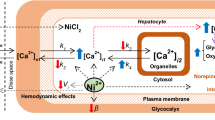Summary
Energy depleted human red cells subsequently exposed to iodoacetate (IAA) develop, upon the addition of Ca, a marked increase in K permeability, while Na permeability is unaltered. The kinetic characteristics of this augmented K permeability indicate that the transport process is membrane mediated. Thus, the inward and outward rate constants for K increase as the concentration of external K is increased reaching maximum values between 2 to 5mm; further increases in external K results in a partial reduction of the rate constants. In addition, the Ca-stimulated K transport system displays counterflow of42K during its influx when a large gradient of39K exists (inside high, outside low). Furthermore, the Ca-induced K transport is inhibited by ouabain. The sensitivity of the Ca-induced system to ouabain parallels the action of ouabain on the Na−K pump. At least part of the increased K transport occurs through a preexisting pathway since ouabain bound to cells before exposure to Ca and IAA results in an inhibition of K outflux. Since ouabain does not alter the affinity of the cells for Ca, it is concluded that at least a portion of the increased K transport results from Ca acting to increase the turnover rate of the same system which serves as the Na−K pump in normal red cells.
Similar content being viewed by others
References
Blum, R. M., Hoffman, J. F. 1970. Carrier mediation of Ca-induced K and its inhibition in red blood cells.Fed. Proc. 29:663a.
Drabkin, D. L., Austin, J. H. 1936. Spectrophotometric studies. II. Preparations from washed blood cells; nitric oxide hemoglobin and sulfhemoglobin.J. Biol. Chem. 112:51.
Ekman, A., Manninen, V., Salminen, S. 1969. Ion movements in red cells treated with propranolol.Acta Physiol. Scand. 75:333.
Gardos, G. 1956. The permeability of human erythrocytes to potassium.Acta Physiol. Sci. Acad. Hung. 10:185.
— 1959. The role of calcium in the potassium permeability of human erythrocytes.Acta Physiol. Sci. Acad. Hung. 15:121.
Garrahan, P. J., Glynn, I. M. 1967. The stoichiometry of the sodium pump.J. Physiol. 192:217.
Glynn, I. M., Lew, V. L., Lüthi, U. 1970. Reversal of the potassium entry in red cells, with an without reversal of the entire pump cycle.J. Physiol. 207:371.
—, Lüthi, U. 1968. The relation between ouabain-sensitive potassium efflux and the hypothetical dephosphorylation step in the “transport ATPase” system.J. Gen. Physiol. 51:385s.
Heckmann, K. 1965.See Discussion.In: Mechanism of Hormone Action; A NATO advanced study Institute. P. Karlson, editor. p. 57. Academic Press Inc., New York.
Hoffman, J. F. 1962. The active transport of sodium by ghosts of human red blood cells.J. Gen. Physiol. 45:837.
— 1966. The red cell membrane and the transport of sodium and potassium.Amer. J. Med. 41:666.
— Ingram, C. J. 1968. Cation transport and binding ofT-ouabain to intact human red cells.In: Stoffwechsel und Membranepermeabilität von Erythrocyten und Thrombocyten. E. Deutsch, E. Gerlach and K. Moser, editors. p. 420. Georg Thieme Verlag, Stuttgart.
Ingram, C. J. 1969. The binding of ouabain to human red cells. Ph. D. Thesis. Yale University, New Haven, Conn.
Joyce, C. R. B., Moore, H., Weatherall, M. 1954. The effects of lead, mercury and gold on the potassium turnover of rabbit blood cells.Brit. J. Pharmacol. Chemother. 9:463.
Kregenow, F. M. 1962. Metabolic control of passive transfer and exchange diffusion of sodium and potassium in human red blood cells. M. D. Thesis. Yale University, New Haven, Conn.
Kregenow, F. M., Hoffman, J. F. 1962. Metabolic control of passive transport and exchange diffusion of Na and K in human red cells.Biophysical Soc. (Abstract), Wash. TD. II
Lee, K. S., Shin, B. C. 1969. Studies on the active transport of calcium in human red cells.J. Gen. Physiol. 54:713.
Passow, H. 1963. Metabolic control of passive cation permeability in human red cells.In: Cell Interface Reactions. H. D. Brown, editor. Scholar's Library, New York.
— 1970. The red blood cell: Penetration, distribution and toxic action of heavy metals.In: Effects of Metals on Cells, Subcellular Elements and Macromolecules. J. Maniloff, J. R. Coleman and M. Miller, editors. p. 291. Charles C. Thomas, Springfield, Ill.
Sachs, J. R. 1971. Ouabain-insensitive sodium movements in the human red blood cell.J. Gen. Physiol. 57:259.
Schatzmann, H. J., Vincenzi, F. F. 1969. Calcium movements across the membrane of human red cells.J. Physiol. 201:369.
Whittam, R., Wheeler, K. P., Blake, A. 1964. Oligomycin and active transport reactions in cell membranes.Nature 203:720.
Wilbrandt, W., Rosenberg, T. 1961. The concept of carrier transport and its corollaries in pharmacology.Pharmacol. Rev. 13:109.
Author information
Authors and Affiliations
Rights and permissions
About this article
Cite this article
Blum, R.M., Hoffman, J.F. The membrane locus of Ca-stimulated K transport in energy depleted human red blood cells. J. Membrain Biol. 6, 315–328 (1971). https://doi.org/10.1007/BF02116577
Received:
Issue Date:
DOI: https://doi.org/10.1007/BF02116577




